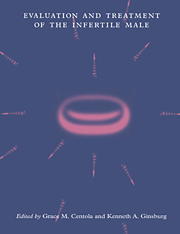Book contents
- Frontmatter
- Contents
- Preface
- List of contributors
- 1 Andrology
- 2 Sperm–egg interaction
- 3 Routine semen analysis
- 4 Computer-aided sperm analysis: a critical review
- 5 Antisperm antibodies: diagnosis and treatment
- 6 The sperm penetration assay
- 7 Intrauterine insemination for male factor
- 8 Processing human semen for insemination: comparison of methods
- 9 New assays for evaluating sperm function
- 10 Assisted reproductive technology for male factor infertility
- 11 Microinjection techniques for male infertility
- 12 Therapeutic donor insemination: screening, indications and technique
- 13 Endocrine assessment and hormone treatment of the infertile male
- 14 The urologic evaluation of the infertile male
- 15 Azoospermia: the diagnosis and treatment
- 16 White blood cells in semen and their impact on fertility
- 17 Psychological aspects of male infertility: lifting the shroud of shame
- 18 Evaluation of the female partner
- Index
14 - The urologic evaluation of the infertile male
Published online by Cambridge University Press: 16 September 2009
- Frontmatter
- Contents
- Preface
- List of contributors
- 1 Andrology
- 2 Sperm–egg interaction
- 3 Routine semen analysis
- 4 Computer-aided sperm analysis: a critical review
- 5 Antisperm antibodies: diagnosis and treatment
- 6 The sperm penetration assay
- 7 Intrauterine insemination for male factor
- 8 Processing human semen for insemination: comparison of methods
- 9 New assays for evaluating sperm function
- 10 Assisted reproductive technology for male factor infertility
- 11 Microinjection techniques for male infertility
- 12 Therapeutic donor insemination: screening, indications and technique
- 13 Endocrine assessment and hormone treatment of the infertile male
- 14 The urologic evaluation of the infertile male
- 15 Azoospermia: the diagnosis and treatment
- 16 White blood cells in semen and their impact on fertility
- 17 Psychological aspects of male infertility: lifting the shroud of shame
- 18 Evaluation of the female partner
- Index
Summary
Introduction
Infertility is defined as the failure to achieve pregnancy after unprotected coitus for at least 1 year. Approximately 15% of couples attempting their first pregnancy are unsuccessful. Diagnosis and treatment are often costly, time consuming, intrusive and for many diagnoses there is a variable but low chance of success. According to the Office of Technology Assessment (OTA, 1988), 2.4 million married couples were defined as infertile in 1982. Voluntary delayed child-bearing may also complicate this situation. The child-bearing potential of a couple is less dependent on the age of the male than the age of the female partner; the average woman experiences a gradual deterioration of her reproductive potential between the ages of 24 and 50 years (Speroff et al., 1989) which may not be apparent in the older man (Nieschlag et al., 1982).
Secondary infertility is defined as the inability to conceive after 1 year of unprotected intercourse following a previously documented pregnancy. Male fertility may have been altered by reproductive toxicants, drugs, inflammatory conditions, varicocele, or unknown factors. A ‘male factor’ is considered important in 40–50% of infertility evaluations (Jouannet et al., 1988).
The evaluation of the infertile couple must be thorough, blameless and should include a review of possible previous pregnancies of both partners. This chapter will discuss the male fertility examination from the perspective of the urologist as andrologist, with an overview of the normal and abnormal male reproductive system.
The male evaluation
The andrologist should emphasize the role of prevention long before the couple presents for evaluation. Education must begin much earlier regarding workplace toxicants and occupational hazards, use of both prescribed and abused drugs, and the long-term role of genital tract infections.
- Type
- Chapter
- Information
- Evaluation and Treatment of the Infertile Male , pp. 215 - 234Publisher: Cambridge University PressPrint publication year: 1996

